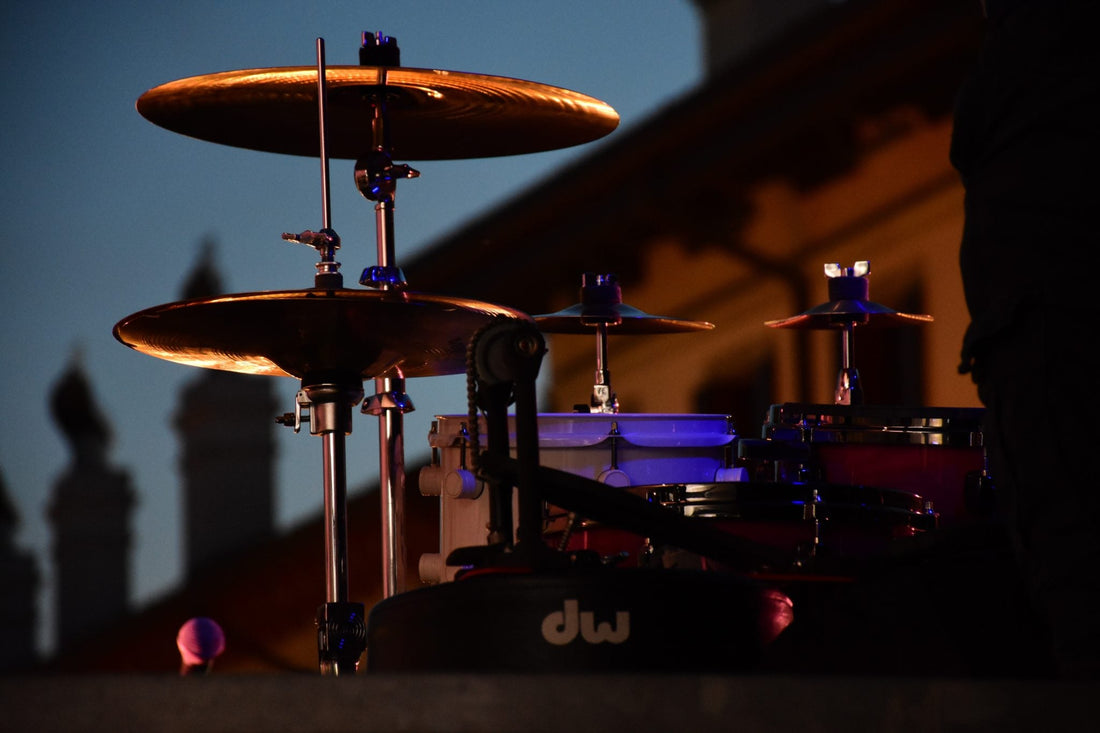
3 Parts of the Drumset You May Not Know About
Share
Drums are one of the world’s oldest musical instrument dating as far back as 5500BC originating in China and eventually spread all across Asia. Later, drums found their way to Africa around 1000BC and was used as a means to communicate and still is in many drum circles today.
Drums have come along way since its creation and despite all the wonderful innovative technologies that have greatly improved the quality of the instrument; the basic design of the drum has practically stayed the same.
In this short blog, I want to discuss 3 things you may not know about Drums.
1. The Drum Shell

The Drum shell is the main part of any drum and is largely responsible for the type of timbre or sound quality the drum produces when you strike your drum head with your drumstick. Drum shells can come in many different shapes and sizes and materials which all have an effect on the drums sound.
One of the most interesting things that I find about drums is that each drum shell has its own unique sound or personality. In African culture, many tribesman believe that when playing this instrument they are able to inhabit the spirit of the tree the shell was made from or the animal the skin was taken from.
Nowadays we use synthetic heads to mimic the sound of an animal hide, but I love the idea that each drum has its own personality due to the materials unique properties.
Below are a list of different types of materials that drums are manufactured in, and what kind of timbre they produce. Some of the different materials can be combined together to make a “Hybrid” Shell –
Woods
- Maple: Even amount of highs and mids, slightly warm lows. All-purpose.
- Birch: Boosted high frequencies, slightly reduced midrange, good low-end punch. Loud and cutting.
- Mahogany: Muted highs, smooth midrange, warm/rich low end. Vibrant and resonant.
- Walnut: Equal amount of highs, mids, and lows. Big and warm.
- Oak: Soft highs, good amount of midrange, slightly warm lows. All-purpose with fairly quick decay.
- Beech: Pronounced highs and mids, good low-end punch. Sensitive and focused.
- Cherry: Boosted highs, punchy midrange, average low end. Bright and sensitive.
- Bubinga: Even amount of highs and mids, rich low end. Sensitive and punchy.
- Poplar: Soft highs and mids, boosted low-end warmth. Smooth and eve.
- Ash: Pronounced, warm highs and mids, average low end. Throaty and warm.
Metals
- Steel (carbon): Clear highs, average midrange and low end. All-purpose.
- Brass: Open highs, mids, and lows. Musically warm and vibrant.
- Aluminum: Crisp highs, warm/open midrange and low end. Colorful and sensitive.
- Copper: Muted highs, pronounced midrange and low end. Loud and powerful.
- Bronze: Muted highs, powerful midrange and low end. Warm and responsive.
- Titanium: Clear highs and mids, boxy low end. Clear and focused.
Synthetics
- Carbon fiber: Even amount of highs and mids, slightly warm low end. Controlled and dry.
- Acrylic: Warm highs, mids, and low end. Powerful attack and presence.
- Fiberglass: Even amount of highs, mids, and lows. Controlled and focused.
There are various different ways that a drum shell can be constructed with the materials listed above, and this can also contribute to varying sounds these instruments can produce.
When using Wooden shells, they could be constructed with Plywood or Solid Shell which offers long sustain, however the Plywood offers a large dynamic range with plenty of volume whilst the Solid shell generally offers a higher fundamental pitch.
If you would prefer your drums to have a shorter sustain you could opt for a Stave or Segment shell, but whether you prefer a more focused sound, you may opt for the Segment rather than the stave shell as this offers a higher fundamental pitch.
Depending on the wood material, you may even be able to offer a Steam-Bent shell which offers a vibrant sound with long sustain. Craviotto one of the many innovative drum designers use this technology often with their drum sets. You can visit Craviotto’s website here – https://www.craviottodrums.com/
If you prefer the design of a Metal shell, you could look at options such as the Cast shell or Spun Shell. Both of these offer a long sustain due to the metal shell, however a cast shell generally has a higher fundamental pitch, where as the spun has a true fundamental pitch. If you’re looking for a high end metal shell you may want to consider brands such as Dunnett or Ludwig, just to name a few. You can visit Dunnett’s website here – https://www.dunnett.com/
2. Bearing Edges
Some drummers would argue that this topic doesn’t bear thinking about (See what I did there?), but here at Drumstars we understand that different types of hoops can have a dramatic impact on the quality of your drum sound.

“Knowing the general history of how bearing edges have evolved over the last century can help you associate various drum design options with specific sounds and time periods in order to pinpoint exactly what you’re looking for”. – Modern Drummer
3 Types of Bearing Edges
45-degree Edge – This is usually the most common type of bearing edge manufactured on drums. The idea behind this edge is when you place your drum head on top of the shell, less of the drumhead will be in contact with the shell, allowing the drum head to sustain and be more responsive when playing. This is a sharp 1- play thick edge all around the drum as you can see in the image above.
This allows the drum to give more overtones and making the drum sound bright and colourful. Unfortunately this can make tune a little difficult, due to how responsive the heads are with this bearing edge. Of course choosing the right drum head and counter hoop can help you to control this a little better with this type of edge, making it quite a little more versatile
30-degree Edge – The 30 degree bearing edge, often referred to as the vintage edge because it was commonly used on drums from the 1930’s onwards. This edge is thicker than the 45 degree with a rounded-over profile. This allows the drum head to have a little bit more contact with the drum head, making the drum sound more controlled and rounder overtones generally, whilst still allowing the drum shell to express its inherit fundamental sound.
Roundover/Baseball Bat – This type of bearing is completely rounded off at its peak, meaning its in direct contact with the drum head. These types of edges were standard among the drummers in Big band Era until the 1980s when sharper edges became the trend. This type of bearing edge is still used in many Jazz and vintage style kits today, as it provided less attack, a more mellow, warmer feel, that its bright and punchy sharp counterpart.
The Baseball Bat Bearing edge was imagined and designed by the legendary Johnny Craviotto, one of the masters at crafting drums. It is totally unique and his its own place in the custom drum industry. It takes its inspiration from the rounded bearing edges that we discussed above, however it offers a punchier, more articulate sound. If you’re looking for warm overtones and resonant bass drums, similar to the sound of drums in the 1950-1960s, this is your best bet.
3. Counter-Hoops
This an element to the drum set that often goes unnoticed, but depending on the type of hoop you decide to use on your drums, this minor detail can in fact have a huge effect on the quality of your drums overtones.
Tripple Flanged Hoop

Working alongside the Drumshop, I often see various drums come into store that are manufactured and fitted with Triple flanged hoops. This is because they offer a more versatile sound and allow the drums to breathe.
If you’re ever in doubt on what sound you’re looking for, this is definitely the best hoop to start with. From there you can decide whether you’d prefer to reduce the sustain and have a more controlled sound. Choosing the right drum head with the right drum hoop is very important; carefully selecting these options will allow you to get the most optimal overtones from your drum.
If you are confident that you would like more focused and dense tones with a reduced sustain, you could look at options such as Die-Cast or Wooden hoops. Both of these are hoops are usually dense materials which help to reduce the vibration of sound when you’ve stricken the drum head.
Wooden Hoop

Die Cast Hoop

So there we have it….3 things about drums that you may not know about. I often find drummers looking for a particular sound, whether its a recording of a drum set they’ve heard, or want to mimic their drumming idols, its also worth considering these kind of specifications. What type of drum shell did you favourite drummer use? Mahogany, Beech or possibly even Aluminium. Did those shells come with a modern 45 degree edge, or have a little bit more of 1950’s big band feel, and what kind of hoops were they using?
I appreciate that choosing the perfect drum kit isn’t an easy challenge, but hopefully this blog has helped you to consider other possibilities to get that drum sound you love!
If you would like any further advice or information, please do not hesitate to drop is a message.
